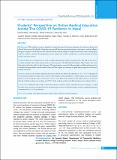Please use this identifier to cite or link to this item:
https://hdl.handle.net/20.500.14356/1325Full metadata record
| DC Field | Value | Language |
|---|---|---|
| dc.contributor.author | Nepal, Samata | - |
| dc.contributor.author | Atreya, Alok | - |
| dc.contributor.author | Menezes, Ritesh G | - |
| dc.contributor.author | Joshi, Ruban Raj | - |
| dc.date.accessioned | 2023-05-07T07:54:34Z | - |
| dc.date.available | 2023-05-07T07:54:34Z | - |
| dc.date.issued | 2020 | - |
| dc.identifier.citation | NepalS., AtreyaA., MenezesR. G., & JoshiR. R. (2020). Students’ Perspective on Online Medical Education Amidst the COVID-19 Pandemic in Nepal. Journal of Nepal Health Research Council, 18(3), 551-555. https://doi.org/10.33314/jnhrc.v18i3.2851 | en_US |
| dc.identifier.issn | JNHRC Print ISSN: 1727-5482; Online ISSN: 1999-6217 | - |
| dc.identifier.uri | http://103.69.126.140:8080/handle/20.500.14356/1325 | - |
| dc.description | Medical Education | en_US |
| dc.description.abstract | Abstract Background: The lockdown strategy adopted to contain the spread of current pandemic of coronavirus disease has affected all sectors of life globally. Nepal also instructed all the educational institutions to shut down, medical colleges being no exception. One month into the lockdown all the medical colleges in Nepal started online classes to keep pace with the academic calendar. This preliminary survey analyses the students’ perspective on newly introduced online medical education system. Methods: This cross-sectional survey used an online questionnaire typed in Google forms. The link to the survey was then emailed to the student representative of each semester of Lumbini Medical College, Palpa, Nepal, who were then instructed to forward it to their classmates. The questionnaire consisted of demographic variables and perspective of medical undergraduates towards online classes and also a space to comment or opine their perspective on current medical education. Results: A total of 226 students responded the survey. Almost one-third of the students (n=173, 76.5%) admitted of never having attended the online classes. Most of the students used smartphones to attend online classes; broadband internet service being the source of internet in 65.5%. Two-third of the students rated online classes to be poorer than the traditional classroom teaching and 77.8% of the students preferred traditional classroom teaching in future. Conclusions: Medical students did not find online classes as effective as the traditional classroom teachings; it could be made more interactive and productive by introducing interactive and brainstorming sessions complementing the conventional face?to?face education. Keywords: COVID-19; medical education, Nepal; online education; virtual education | en_US |
| dc.language.iso | en | en_US |
| dc.publisher | Nepal Health Research Council | en_US |
| dc.subject | COVID-19 | en_US |
| dc.subject | Medical education | en_US |
| dc.subject | Nepal | en_US |
| dc.subject | Online education | en_US |
| dc.subject | Virtual education | en_US |
| dc.title | Students’ Perspective on Online Medical Education Amidst the COVID-19 Pandemic in Nepal | en_US |
| dc.type | Journal Article | en_US |
| local.journal.category | Medical Education | - |
| Appears in Collections: | Vol. 18 No. 3 (2020): Vol. 18 No. 3 Issue 48 Jul-Sep 2020 | |
Files in This Item:
| File | Description | Size | Format | |
|---|---|---|---|---|
| 2851-Manuscript-18859-1-10-20201115.pdf | Fulltext Article. | 167.05 kB | Adobe PDF |  View/Open |
Items in DSpace are protected by copyright, with all rights reserved, unless otherwise indicated.
